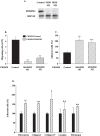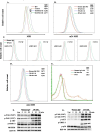MOSPD2 regulates the activation state of αLβ2 integrin to control monocyte migration: applicability for treatment of chronic inflammatory diseases
- PMID: 40312574
- PMCID: PMC12045827
- DOI: 10.1007/s12026-025-09633-6
MOSPD2 regulates the activation state of αLβ2 integrin to control monocyte migration: applicability for treatment of chronic inflammatory diseases
Abstract
Monocytes are innate immune cells that drive the chronicity of various inflammatory diseases. Monocyte migration to inflamed tissues involves multiple steps of interaction with the vascular endothelium and the extracellular matrix (ECM), a process mediated through conformational transitions in cell surface integrins. We previously described motile sperm domain-containing protein 2 (MOSPD2) as a surface protein expressed on myeloid cells that is essential for the migration of monocytes and a key regulator of inflammation. Investigating MOSPD2's mechanism of action, we assessed whether it plays a role in regulating integrin activation and monocyte adhesion. Data show that silencing of MOSPD2 expression in the THP-1 monocytic cell line significantly increased cell adhesion to various ECM molecules. Employing IW-601, a humanized anti-human MOSDP2 monoclonal antibody, on primary human monocytes increased adhesion to ECM molecules as well as to adhesion molecules. At the molecular level, silencing of MOSPD2 or blocking MOSPD2 using IW-601 led to a transition in integrin αLβ2 (CD11a/CD18, LFA-1) conformation into an active high-affinity binding form and to the induction of adhesion-associated signaling pathways. Co-immunoprecipitation experiments showed that MOSPD2 binds integrin-β2 (CD18), but not integrin-β1 (CD29). Our results reveal a novel mechanism controlling monocyte migration, in which MOSPD2 acts as an adhesion checkpoint that governs the balance between monocyte adhesion and release. By demonstrating the inhibitory effect of IW-601 on the migration of primary monocytes isolated from patients with chronic inflammatory diseases, we provide proof of concept for translating MOSPD2's mechanism into a potential treatment for inflammatory diseases, further supported by in vivo data in models of RA and IBD.
Keywords: Adhesion; Checkpoint; Inflammation; MOSPD2; Migration; αLβ2.
© 2025. The Author(s).
Conflict of interest statement
Declarations. Ethical approval: All animal experiments described in this paper were approved by the Institutional Animal Care and Use Committee of the Sheba Medical Center, Ramat Gan, Israel. Venous blood samples were drawn from patients in compliance with the Institutional Review Board at the Tel Aviv Sourasky Medical Center, Tel Aviv, Israel. Consent to participate: Signed informed consent was received from all participants prior to sample donation. Permission to reproduce material from other resources: Not applicable. Competing interests: Niva Yacov, Oshrat Propheta-Meiran, and Itzhak Mendel are employees of ImmuneWalk Therapeutics.
Figures







Similar articles
-
Identification of Motile Sperm Domain-Containing Protein 2 as Regulator of Human Monocyte Migration.J Immunol. 2017 Mar 1;198(5):2125-2132. doi: 10.4049/jimmunol.1601662. Epub 2017 Jan 30. J Immunol. 2017. PMID: 28137892 Free PMC article.
-
Contribution of CD11a/CD18, CD11b/CD18, ICAM-1 (CD54) and -2 (CD102) to human monocyte migration through endothelium and connective tissue fibroblast barriers.Eur J Immunol. 1998 Jun;28(6):1970-9. doi: 10.1002/(SICI)1521-4141(199806)28:06<1970::AID-IMMU1970>3.0.CO;2-H. Eur J Immunol. 1998. PMID: 9645379
-
MOSPD2 is a therapeutic target for the treatment of CNS inflammation.Clin Exp Immunol. 2020 Aug;201(2):105-120. doi: 10.1111/cei.13448. Epub 2020 May 18. Clin Exp Immunol. 2020. PMID: 32353176 Free PMC article.
-
The effect of anti-integrin monoclonal antibodies on antigen-induced pulmonary inflammation in allergic rabbits.Pulm Pharmacol Ther. 2003;16(5):279-85. doi: 10.1016/S1094-5539(03)00069-5. Pulm Pharmacol Ther. 2003. PMID: 12877819 Review.
-
β2 Integrins As Regulators of Dendritic Cell, Monocyte, and Macrophage Function.Front Immunol. 2017 Dec 20;8:1866. doi: 10.3389/fimmu.2017.01866. eCollection 2017. Front Immunol. 2017. PMID: 29326724 Free PMC article. Review.
Cited by
-
Toward Precision Medicine: Molecular Biomarkers of Response to Tofacitinib in Inflammatory Bowel Disease.Genes (Basel). 2025 Jul 29;16(8):908. doi: 10.3390/genes16080908. Genes (Basel). 2025. PMID: 40869955 Free PMC article. Review.
References
-
- Sun Z, Costell M, Fässler R. Integrin activation by talin, kindlin and mechanical forces. Nat Cell Biol. 2019;21:25–31. - PubMed
MeSH terms
Substances
LinkOut - more resources
Full Text Sources

